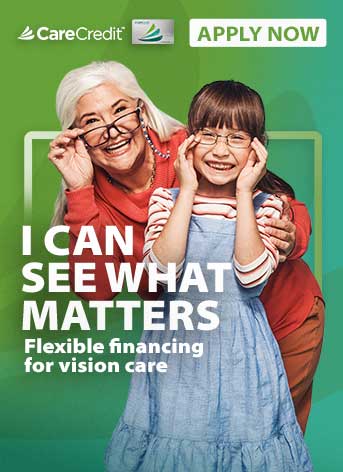As you age, you may find you're squinting more when trying to read texts on your phone or prescription labels. Objects close to your eyes may not be as clear as they used to be. (Don't worry — this is perfectly normal!)
While some people may resolve this by simply getting a pair of reading glasses, that's not really a viable solution if you're already wearing contacts or glasses to help with a different vision problem. If you're looking for alternatives to help correct this new vision issue, bifocal contact lenses can be a convenient solution.
What Are Bifocal Contact Lenses?
Bifocal lenses are unique contacts that allow you to combine two prescriptions into one lens, helping you see both near and far.1 Many people prefer bifocal contacts to glasses and find them enjoyable to wear.
Types
Bifocal contacts come in two main types:1
- Segmented. The upper part of the lens has one prescription, and the lower part has the other. Typically, you'll look down to use the near vision (such as when you're reading), and your distance vision will be in the top half.
- Concentric or simultaneous. Your regular vision prescription will be in the center of your lens, and the ring surrounding it will have your near vision prescription.
You can also choose different options for your bifocal contacts, such as:
- Time increments. Do you want contacts you dispose of at the end of the day? Or would you rather wear the same ones every day for a week or month, only taking them off at night when you sleep?2
- Soft or hard. Bifocal lenses can come in the form of soft contacts for comfort or rigid gas-permeable (hard) contacts for sharper vision and more durability.3
What Do Bifocal Contact Lenses Treat?
Bifocal contact lenses are prescribed for people with presbyopia.1 This is a condition that naturally occurs as you age.4 Your eye's lens becomes less flexible, which makes it harder for you to focus on things up close, like reading a book or your computer screen.4
If your vision was already fine before you developed presbyopia, then you'll likely just need reading glasses. But if you already need a prescription for another refractive vision issue, like nearsightedness, farsightedness or astigmatism, then your eye doctor may suggest bifocal contacts.5
Bifocal contact lenses are divided into two sections: one part corrects presbyopia (allowing you to read things up close again), and the other part uses your second prescription (allowing you to see things from a distance).2
Bifocal vs. Multifocal Contact Lenses
When treating presbyopia, you can choose from different types of contact lenses, not just bifocals. Some choose monovision lenses, where they wear a contact prescribed for near vision in one eye and one contact prescribed for distance in the other. But if this isn't your style, you'll likely be choosing between bifocal and multifocal contacts.5
Bifocal contacts let you manually switch your vision between your near and far prescriptions since the lens is divided into two prescription zones. This is similar to how bifocal glasses work. In contrast, multifocal lenses create a more gradual transition between two (or more) prescriptions.1
But while multifocals allow for a more natural transition, they do have drawbacks. They can be tougher to get used to than bifocal contacts, and they may cause you to see glare at night or have hazy vision as you adjust.6
Bifocal Contact Lens Costs
The national average cost* of bifocal contacts is $505 per month but can range from $388 to $970. Exactly how much your contacts will cost can vary depending on factors like the exact prescription you need, where you live or the brand you choose.7
Another factor affecting cost is whether you choose daily, weekly, twice-a-month or monthly contacts. While daily disposable contacts may cost less at first, they'll ultimately cost more per year because you'll end up needing a much higher volume of lenses in total.
Average bifocal contact lens cost by state/district
Below is a breakdown of the average cost* of bifocal contacts by all 50 states and the District of Columbia.7
| State/District | Average cost |
|---|---|
| Alabama | $424 |
| Alaska | $613 |
| Arizona | $507 |
| Arkansas | $429 |
| California | $635 |
| Colorado | $502 |
| Connecticut | $531 |
| Delaware | $503 |
| District of Columbia | $629 |
| Florida | $502 |
| Georgia | $460 |
| Hawaii | $805 |
| Idaho | $514 |
| Illinois | $518 |
| Indiana | $462 |
| Iowa | $443 |
| Kansas | $446 |
| Kentucky | $451 |
| Louisiana | $472 |
| Maine | $510 |
| Maryland | $571 |
| Massachusetts | $614 |
| Michigan | $459 |
| Minnesota | $469 |
| Mississippi | $434 |
| Missouri | $444 |
| Montana | $492 |
| Nebraska | $458 |
| Nevada | $500 |
| New Hampshire | $517 |
| New Jersey | $551 |
| New Mexico | $456 |
| New York | $557 |
| North Carolina | $466 |
| North Dakota | $461 |
| Ohio | $463 |
| Oklahoma | $439 |
| Oregon | $541 |
| Pennsylvania | $495 |
| Rhode Island | $521 |
| South Carolina | $467 |
| South Dakota | $440 |
| Tennessee | $446 |
| Texas | $463 |
| Utah | $505 |
| Vermont | $532 |
| Virginia | $491 |
| Washington | $560 |
| West Virginia | $450 |
| Wisconsin | $470 |
| Wyoming | $475 |
Does Insurance Cover Bifocal Lenses?
Vision insurance often covers at least part of the cost of your bifocal lenses. However, exactly how much varies from plan to plan. Some plans will only cover a specific amount per year. Others may offer discounts on your contacts.8
Remember: Even if your lenses are covered, you'll still need to meet your deductible and out-of-pocket costs before full coverage applies.8 In some circumstances, you may be able to use benefits like your HSA (health savings account) or FSA (flexible savings account) to help offset some of your costs.9 But you'll want to have a financing alternative in mind in case your out-of-pocket cost is high.
Who Is a Good Candidate for Wearing Bifocal Lenses?
You're a good candidate for bifocal contacts if:1
- You're over 40 and experiencing presbyopia.5
- You don't want to wear reading glasses.
- You already are wearing contacts for a different vision issue, like astigmatism or myopia, and just developed presbyopia, too.9
- You can adjust to shifting your vision between the near and distance zones on a bifocal lens.
You may not be a good candidate if:9
- You use the computer frequently for work. This could lead to eye strain, especially with segmented bifocal contacts.1
- You already have at least two more vision issues in addition to presbyopia (such as having both astigmatism and myopia). In this case, bifocals might not provide enough correction, and you may need multifocals.
- You have chronic dry eye, which can affect your ability to wear any contact lenses. In this case, glasses would be better.
More Information About Bifocal Contacts
Here are the basics you'll want to know about getting and wearing bifocal contacts.
How to get them
You can only get bifocal contacts with a prescription after visiting your optometrist or ophthalmologist for an eye exam. Your doctor will discuss your lifestyle (such as if you have a long commute or do a lot of computer work) to help determine the type of contacts that are best for you.2
How to put them in
Putting in bifocal contacts is no different than putting in your regular contact lenses. However, you may need to adjust them just a bit once they're in to make sure the two focus zones are comfortable for you.2
Care and maintenance
Caring for bifocal contacts is no different than regular contact lenses. Use the contact lens solution your doctor suggests to clean them every day. (If you have daily lenses, you'll discard them each day after you wear them.) Store your contacts in a clean case with fresh solution when you're not wearing them.3
Remember: Don't sleep in your contact lenses unless they are designed for overnight use. Sleeping in them can increase your chance of eye infections.3
Safety Considerations
Bifocal contacts are perfectly safe. In fact, many eye doctors believe these are safer (and faster to adjust to) than the older monovision solution of wearing a different prescription in each eye.2
But as with any new prescription, they can have potential side effects, such as:2
- Chronic dry eye
- Glares or halos in your vision (often from dry eyes)
- Headaches or eye strain as you adjust
- Itching sensation from dry eyes
- Problems with depth perception1 (however, monovision contacts are more likely to cause this issue10)
- Trouble seeing at night
- Vision correction not as clear as you hoped
The good news is that many people never experience these side effects or notice them diminishing as they adjust to their new contacts.
Frequently Asked Questions About Bifocal Contacts
Do you still have questions about bifocal contact lenses? Here are answers to some commonly asked questions about them.
Financing Bifocal Contact Lenses With the CareCredit Credit Card
Whether you’re purchasing stylish new frames, getting contacts or due for an eye exam, the CareCredit credit card can help you pay for care where your insurance leaves off.** Use our Acceptance Locator to find a vision specialist near you that accepts CareCredit so you can see all that life has to offer. Continue your wellness journey by downloading the CareCredit Mobile App to manage your account, find a provider on the go and easily access the Well U blog for more great articles, podcasts and videos.
In addition to vision care, you can also use your CareCredit credit card for dentistry, cosmetic, pet care, hearing, health systems, dermatology, pharmacy purchases, spa treatments and so much more within the CareCredit network. How will you invest in your health and wellness next?
Author Bio
Stephanie Dwilson specializes in science journalism, breaking news and animal health and is a business owner, non-practicing attorney and writer.








